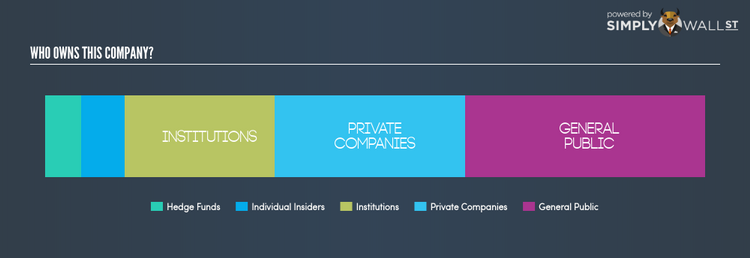Should You Be Concerned About Axsome Therapeutics Inc’s (NASDAQ:AXSM) Investors?

In this analysis, my focus will be on developing a perspective on Axsome Therapeutics Inc’s (NASDAQ:AXSM) latest ownership structure, a less discussed, but important factor. The impact of a company’s ownership structure affects both its short- and long-term performance. Since the same amount of capital coming from an activist institution and a passive mutual fund has different implications on corporate governance, it is a useful exercise to deconstruct AXSM’s shareholder registry.
See our latest analysis for Axsome Therapeutics
Institutional Ownership
With an institutional ownership of 22.72%, AXSM can face volatile stock price movements if institutions execute block trades on the open market, more so, when there are relatively small amounts of shares available on the market to trade Although AXSM has a high institutional ownership, such stock moves, in the short-term, are more commonly linked to a particular type of active institutional investors – hedge funds. Considering hedge funds hold a stake of 5.52% in the company, AXSM shares may experience high short-term volatility as this class of institutions are frequently found to sell significantly during market-wide shocks. We should dig deeper into the company’s ownership structure to find how the rest of its ownership structure can impact its investment case.
Insider Ownership
I find insiders are another important group of stakeholders, who are directly involved in making key decisions related to the use of capital. In essence, insider ownership is more about the alignment of shareholders’ interests with the management. 6.62% ownership makes insiders an important shareholder group. This level of ownership indicates closely aligned interests of shareholders and management. However, it would be interesting to take a look at their buying and selling activities lately. Buying may be sign of upbeat future expectations, but selling doesn’t necessarily mean the opposite as the insiders may be motivated by financial needs or they are simply diversifying their risk.
General Public Ownership
A substantial ownership of 36.30% in AXSM is held by the general public. With this size of ownership, retail investors can collectively play a role in major company policies that affect shareholders returns, including executive remuneration and the appointment of directors. They can also exercise the power to decline an acquisition or merger that may not improve profitability.
Private Company Ownership
Potential investors in AXSM should also look at another important group of investors: private companies, with a stake of 28.83%, who are primarily invested because of strategic and capital gain interests. This kind of ownership, if predominantly strategic, can give these companies a significant power to affect AXSM’s business strategy. Thus, potential investors should look into these business relations and check how it can impact long-term shareholder returns.
Next Steps:
I suggest investors seek some degree of margin of safety due to high institutional ownership in AXSM, in particular due to the strong presence of active hedge fund investors. This will allow an investor to reduce the impact of non-fundamental factors, such as volatile block trading impact on their portfolio value. However, ownership structure should not be the only determining factor when you’re building an investment thesis for AXSM. Instead, you should be evaluating company-specific factors such as the intrinsic valuation, which is a key driver of Axsome Therapeutics’s share price. I highly recommend you to complete your research by taking a look at the following:
Financial Health: Is AXSM’s operations financially sustainable? Balance sheets can be hard to analyze, which is why we’ve done it for you. Check out our financial health checks here.
Other High-Performing Stocks: Are there other stocks that provide better prospects with proven track records? Explore our free list of these great stocks here.
NB: Figures in this article are calculated using data from the last twelve months, which refer to the 12-month period ending on the last date of the month the financial statement is dated. This may not be consistent with full year annual report figures.
To help readers see pass the short term volatility of the financial market, we aim to bring you a long-term focused research analysis purely driven by fundamental data. Note that our analysis does not factor in the latest price sensitive company announcements.
The author is an independent contributor and at the time of publication had no position in the stocks mentioned.

